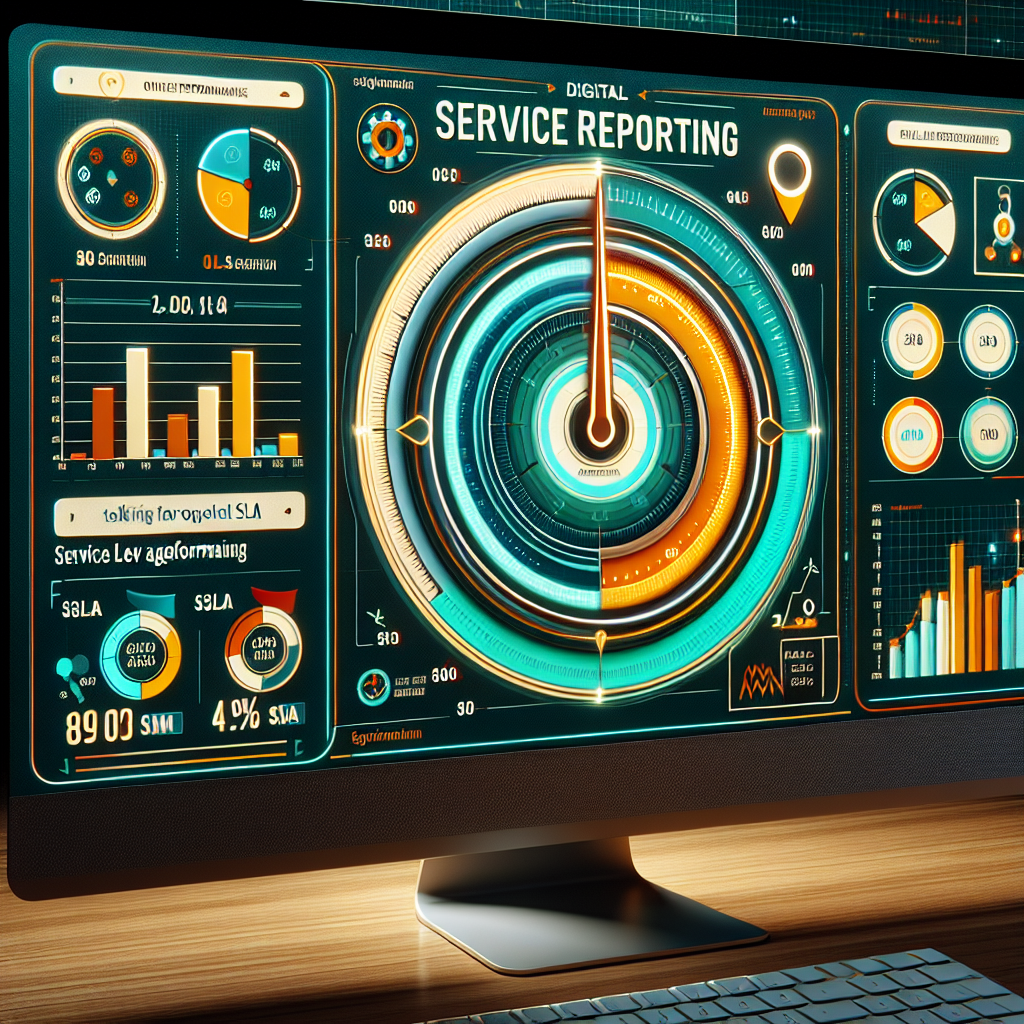Your cart is currently empty!
Tag: Performance

Monitoring and Measuring Performance under a Service Level Agreement (SLA)
Monitoring and measuring performance under a Service Level Agreement (SLA) is crucial for ensuring that both parties involved in the agreement are meeting their commitments and expectations. An SLA is a formal contract between a service provider and a customer that outlines the level of service that will be provided, including performance metrics and expectations.Monitoring and measuring performance under an SLA involves tracking key performance indicators (KPIs) to ensure that both parties are meeting their agreed-upon standards. These KPIs can include metrics such as uptime, response time, resolution time, and customer satisfaction.
One of the main benefits of monitoring and measuring performance under an SLA is that it allows both parties to identify any areas where the agreed-upon standards are not being met. This allows for quick action to be taken to address any issues and prevent them from escalating.
There are several ways to monitor and measure performance under an SLA. One common method is to use a monitoring tool that tracks KPIs in real-time and provides alerts when performance falls below acceptable levels. Another method is to regularly review performance reports and conduct regular performance reviews with both parties to discuss any issues and potential improvements.
In addition to monitoring performance, it is also important to establish a process for resolving any issues that arise. This can involve setting up a formal escalation process that outlines the steps to be taken if performance falls below acceptable levels. It is also important to document any performance issues and resolutions to ensure that both parties are held accountable for their commitments.
Overall, monitoring and measuring performance under an SLA is essential for ensuring that both parties are meeting their obligations and delivering the level of service expected. By tracking KPIs, identifying issues, and taking prompt action to address any issues, both parties can ensure a successful partnership and maintain a high level of customer satisfaction.

Maximizing Asset Performance with Proactive Maintenance
Maximizing Asset Performance with Proactive MaintenanceIn today’s fast-paced business environment, companies are constantly looking for ways to improve efficiency and reduce costs. One area where significant gains can be made is in asset management. By implementing proactive maintenance strategies, companies can ensure that their assets are running at peak performance levels, leading to increased productivity, reduced downtime, and ultimately, higher profits.
Proactive maintenance is a preventative approach to asset management that focuses on identifying and addressing potential issues before they escalate into major problems. By regularly monitoring equipment and performing routine maintenance tasks, companies can extend the lifespan of their assets and avoid costly repairs or replacements.
One key benefit of proactive maintenance is the ability to schedule maintenance activities during downtime periods, minimizing disruption to operations. By conducting regular inspections and servicing, companies can identify and address issues early on, preventing unexpected breakdowns and ensuring that assets are operating efficiently.
Another advantage of proactive maintenance is the ability to optimize asset performance through data-driven decision-making. By collecting and analyzing data on asset performance, companies can identify trends and patterns that can help them make informed decisions about maintenance schedules and resource allocation. This can lead to more efficient use of resources and improved asset performance over time.
In addition to improving asset performance, proactive maintenance can also help companies comply with regulatory requirements and industry standards. By keeping detailed records of maintenance activities and inspections, companies can demonstrate compliance with regulations and ensure that assets are operating safely and reliably.
To implement a proactive maintenance program, companies should invest in tools and technologies that enable them to monitor asset performance in real-time, such as sensors, IoT devices, and predictive maintenance software. By leveraging these technologies, companies can proactively identify issues and take corrective action before they impact operations.
Overall, proactive maintenance is a critical component of effective asset management. By taking a preventative approach to maintenance, companies can maximize asset performance, reduce downtime, and ultimately, achieve higher levels of productivity and profitability. By investing in proactive maintenance strategies, companies can position themselves for long-term success in today’s competitive business landscape.

How to Improve Security and Performance Through Network Management
In today’s digital age, network management is crucial for businesses to ensure the security and performance of their networks. With cyber threats becoming more sophisticated and prevalent, it is essential for organizations to have a comprehensive network management strategy in place to protect their sensitive data and maintain optimal performance.Here are some tips on how to improve security and performance through network management:
1. Implement strong security measures: One of the first steps in improving network security is to implement strong security measures such as firewalls, intrusion detection systems, and encryption protocols. Regularly updating these security measures and performing security audits can help identify and address vulnerabilities in the network.
2. Monitor network traffic: Monitoring network traffic is essential for detecting unusual or suspicious activity that could indicate a security breach. Network monitoring tools can provide real-time insights into network performance and help identify potential security threats before they escalate.
3. Segment the network: Segmenting the network into different zones or subnetworks can help contain security breaches and prevent them from spreading across the entire network. By segmenting the network, organizations can limit access to sensitive data and resources, making it harder for hackers to gain unauthorized access.
4. Implement network access controls: Implementing network access controls can help limit access to the network to authorized users only. This can include using strong authentication methods such as multi-factor authentication and role-based access controls to ensure that only authorized users have access to sensitive data and resources.
5. Regularly update software and firmware: Keeping software and firmware up to date is essential for protecting the network from known vulnerabilities and security threats. Regularly updating software and firmware can help patch security vulnerabilities and ensure that the network is running on the latest security patches.
6. Optimize network performance: In addition to improving security, network management also plays a crucial role in optimizing network performance. By regularly monitoring network performance metrics such as bandwidth usage, latency, and packet loss, organizations can identify and address performance bottlenecks that could impact the overall performance of the network.
7. Implement quality of service (QoS) policies: Implementing quality of service (QoS) policies can help prioritize network traffic based on specific criteria such as bandwidth requirements or latency sensitivity. By prioritizing critical network traffic, organizations can ensure that important applications and services receive the necessary bandwidth and resources to operate efficiently.
In conclusion, network management is essential for improving security and performance in today’s digital landscape. By implementing strong security measures, monitoring network traffic, segmenting the network, implementing network access controls, regularly updating software and firmware, optimizing network performance, and implementing quality of service policies, organizations can enhance the security and performance of their networks and protect their sensitive data from cyber threats.

Key Metrics for Evaluating Network Performance
When it comes to evaluating the performance of a network, there are several key metrics that need to be considered. These metrics provide valuable insights into how well a network is functioning and can help identify areas for improvement. By monitoring these key metrics regularly, network administrators can ensure that their network is operating at peak efficiency and delivering the best possible experience for users.One of the most important metrics for evaluating network performance is bandwidth utilization. Bandwidth refers to the amount of data that can be transmitted over a network connection in a given period of time. Monitoring bandwidth utilization can help administrators identify potential bottlenecks or congestion points in the network that may be causing slowdowns or disruptions in service. By keeping a close eye on bandwidth utilization, administrators can proactively address issues before they impact users.
Another important metric to consider is latency, which refers to the time it takes for data to travel from one point in the network to another. High latency can result in slow response times and poor performance for users, particularly in applications that require real-time data transmission, such as video conferencing or online gaming. By monitoring latency levels, administrators can pinpoint areas of the network that may be causing delays and take steps to optimize performance.
Packet loss is another key metric to evaluate when assessing network performance. Packet loss occurs when data packets are dropped or lost during transmission, leading to errors and retransmissions that can degrade network performance. Monitoring packet loss rates can help administrators identify network issues such as network congestion, faulty hardware, or misconfigured settings that may be causing packet loss. By addressing these issues, administrators can improve network reliability and performance.
Network uptime is also an important metric to consider when evaluating network performance. Uptime refers to the amount of time that a network is available and operational, and downtime can have a significant impact on productivity and user satisfaction. By monitoring uptime levels and identifying potential causes of downtime, administrators can take steps to proactively prevent outages and ensure that the network remains reliable and available for users.
In addition to these key metrics, administrators may also want to consider other factors such as network security, quality of service (QoS), and overall network performance. By regularly monitoring and evaluating these metrics, administrators can ensure that their network is operating at peak efficiency and delivering the best possible experience for users. By taking a proactive approach to network performance monitoring, administrators can identify and address issues before they impact users, helping to maintain a reliable and high-performing network.

Measuring and Reporting on Service Level Agreement (SLA) Performance
Measuring and Reporting on Service Level Agreement (SLA) PerformanceService Level Agreements (SLAs) are crucial in ensuring that service providers meet the expectations and requirements of their clients. An SLA is a contract that defines the level of service that a customer can expect from a provider, including metrics such as response time, uptime, and resolution time. To ensure that these metrics are being met, it is important to measure and report on SLA performance regularly.
Measuring SLA performance involves monitoring key metrics and comparing them to the targets set in the SLA. This can be done using various tools and techniques, such as performance monitoring software, surveys, and feedback from customers. By tracking these metrics, service providers can identify areas where they are falling short and take corrective action to improve their performance.
Reporting on SLA performance is equally important, as it allows both the service provider and the customer to assess how well the SLA is being met. Reports should be clear, concise, and easy to understand, highlighting key metrics and trends over time. This information can be shared with stakeholders, such as management, customers, and internal teams, to demonstrate the provider’s commitment to delivering high-quality service.
There are several benefits to measuring and reporting on SLA performance. For service providers, it allows them to identify areas for improvement and make necessary changes to meet customer expectations. It also helps build trust and credibility with customers, as they can see that the provider is actively monitoring and addressing performance issues. For customers, it provides transparency and accountability, ensuring that they are getting the level of service they are paying for.
In conclusion, measuring and reporting on SLA performance is essential for both service providers and customers. By tracking key metrics and sharing this information with stakeholders, providers can ensure that they are meeting their obligations under the SLA and continuously improving their service delivery. Customers can also benefit from this transparency, knowing that their provider is committed to delivering high-quality service. Ultimately, effective measurement and reporting on SLA performance can help build strong and lasting relationships between service providers and their customers.

How to Optimize Network Performance through Effective Management
In today’s fast-paced digital world, having a well-optimized network is crucial for businesses to stay competitive and ensure smooth operations. A poorly managed network can lead to slow speeds, downtime, and security vulnerabilities, all of which can have a negative impact on productivity and customer satisfaction. To avoid these issues and maximize network performance, it’s important for organizations to implement effective management strategies. Here are some tips on how to optimize network performance through effective management:1. Regular Monitoring and Analysis: One of the key aspects of network management is regular monitoring and analysis of network performance. By using monitoring tools and software, IT teams can track network traffic, identify bottlenecks, and pinpoint areas that need improvement. This data can help organizations make informed decisions about network upgrades and modifications to optimize performance.
2. Implement Quality of Service (QoS): Quality of Service (QoS) is a network management technique that prioritizes certain types of traffic over others. By setting QoS policies, organizations can ensure that critical applications, such as VoIP or video conferencing, receive the necessary bandwidth and low latency to function properly. This can help prevent network congestion and improve overall performance.
3. Network Segmentation: Network segmentation involves dividing the network into smaller, more manageable segments to improve security and performance. By isolating different types of traffic or devices into separate segments, organizations can reduce the risk of attacks spreading across the network and improve overall performance by reducing congestion.
4. Regular Maintenance and Updates: Like any other system, networks require regular maintenance and updates to ensure optimal performance. IT teams should regularly update firmware, software, and security patches to address vulnerabilities and improve performance. Regular maintenance can also help prevent network issues before they become major problems.
5. Load Balancing: Load balancing is a network management technique that distributes network traffic evenly across multiple servers or network devices. By balancing the load, organizations can prevent any single device from becoming overwhelmed and ensure that resources are utilized efficiently. This can help improve network performance and prevent downtime.
6. Network Optimization Tools: There are a variety of network optimization tools available that can help organizations improve network performance. These tools can analyze network traffic, optimize configurations, and provide insights into network performance issues. By leveraging these tools, organizations can proactively address performance issues and improve network efficiency.
In conclusion, optimizing network performance through effective management is essential for businesses to stay competitive and ensure smooth operations. By implementing monitoring and analysis, QoS policies, network segmentation, regular maintenance and updates, load balancing, and network optimization tools, organizations can improve network performance, enhance security, and maximize productivity. Investing in network management strategies can help organizations stay ahead of the curve and ensure their networks are running at peak performance.

Measuring Success: Metrics for Evaluating IT Infrastructure Management Performance
Measuring Success: Metrics for Evaluating IT Infrastructure Management PerformanceIn today’s fast-paced business environment, the success of an organization’s IT infrastructure management is critical for ensuring optimal performance and productivity. However, evaluating the performance of IT infrastructure management can be a complex task, as it involves various factors and metrics that need to be considered. To effectively measure the success of IT infrastructure management, organizations need to establish key performance indicators (KPIs) and metrics that provide a comprehensive view of their performance.
One of the most important metrics for evaluating IT infrastructure management performance is uptime. Uptime refers to the amount of time that a system or service is available and operational. High uptime is essential for ensuring that employees can access the resources they need to perform their tasks efficiently. Organizations should track their uptime regularly and strive to achieve as close to 100% uptime as possible.
Another key metric for evaluating IT infrastructure management performance is response time. Response time measures the amount of time it takes for a system or service to respond to a user’s request. Slow response times can lead to frustration among employees and customers, as well as decreased productivity. Organizations should monitor their response times and work to optimize their systems and services to ensure quick and efficient responses.
Capacity utilization is another important metric for evaluating IT infrastructure management performance. Capacity utilization measures how effectively an organization is utilizing its resources, such as storage, processing power, and network bandwidth. High capacity utilization can indicate that an organization is efficiently using its resources, while low capacity utilization may suggest that resources are being underutilized. Organizations should regularly assess their capacity utilization and make adjustments as needed to optimize resource usage.
Security is also a crucial aspect of IT infrastructure management performance. Organizations should track metrics such as the number of security incidents, the response time to security incidents, and the effectiveness of security measures in place. High levels of security incidents or slow response times can indicate vulnerabilities in an organization’s infrastructure, which can put sensitive data at risk. Organizations should prioritize security and regularly assess and improve their security measures to protect their systems and data.
In conclusion, measuring the success of IT infrastructure management requires a comprehensive approach that takes into account various metrics and KPIs. By tracking metrics such as uptime, response time, capacity utilization, and security, organizations can gain valuable insights into the performance of their IT infrastructure management and make informed decisions to optimize their systems and services. By continually monitoring and evaluating these metrics, organizations can ensure that their IT infrastructure management is performing at its best and supporting the overall success of the organization.

How to Measure and Improve Help Desk Performance Metrics
In today’s fast-paced business environment, having an efficient and effective help desk is essential for providing top-notch customer support. One key aspect of managing a help desk is measuring and improving performance metrics. By tracking and analyzing key metrics, help desk managers can identify areas for improvement and optimize their team’s performance.There are several key performance metrics that help desk managers should focus on measuring, including:
1. First response time: This metric measures how quickly a help desk agent responds to a customer’s request. A low first response time is crucial for ensuring customer satisfaction and resolving issues in a timely manner.
2. Resolution time: This metric measures how long it takes for a help desk agent to resolve a customer’s issue. A high resolution time can lead to customer frustration and dissatisfaction, so it is important to track and improve this metric.
3. Customer satisfaction: Customer satisfaction is a key indicator of how well the help desk is performing. By collecting feedback from customers after each interaction, help desk managers can identify areas for improvement and ensure that customers are receiving the support they need.
4. Ticket volume: This metric measures the number of tickets or requests that the help desk receives over a certain period of time. Tracking ticket volume can help managers identify trends and allocate resources more effectively.
To improve help desk performance metrics, there are several strategies that managers can implement:
1. Provide ongoing training and development for help desk agents to ensure they have the skills and knowledge needed to effectively resolve customer issues.
2. Implement a knowledge base or self-service portal to empower customers to find solutions to common problems on their own, reducing the volume of tickets received by the help desk.
3. Use a ticketing system to track and prioritize customer requests, ensuring that agents are addressing the most urgent issues first.
4. Regularly review and analyze performance metrics to identify areas for improvement and set goals for the team.
By measuring and improving help desk performance metrics, managers can ensure that their team is providing high-quality support to customers and continuously striving to enhance their service delivery. By implementing these strategies, help desk managers can optimize their team’s performance and drive customer satisfaction.
Can Tesla’s Model 3 Performance Outrun the Legendary BMW M3 CS?
- The Tesla Model 3 Performance excels in acceleration, achieving 0-60 mph in just 3.1 seconds.
- Its electric motor provides instant torque, contributing to a distinct driving experience with sustainable benefits.
- The BMW M3 CS features a powerful combustion engine known for its exceptional handling and a driving experience that engages the driver’s senses.
- With a 0-60 mph time of approximately 3.8 seconds, the M3 CS emphasizes performance over raw speed, embracing traditional driving craftsmanship.
- This showdown illustrates the diverse offerings in high-performance vehicles, appealing to different automotive enthusiasts.
In the world of high-performance cars, few rivalries ignite passion like that between Tesla’s Model 3 Performance and BMW’s iconic M3 CS. Buckle up as we dive into this electrifying showdown that might surprise even the most devoted car enthusiasts!
The Tesla Model 3 Performance, with its jaw-dropping acceleration and futuristic tech, goes from 0 to 60 mph in just 3.1 seconds. Imagine the thrill as you feel the instant torque propelling you forward, the whir of its electric motor harmonizing with your heart rate. With a sleek design and an impressive range, this electric powerhouse not only promises speed but also delivers a sustainable driving experience.
On the other side of this fierce competition is the BMW M3 CS, a legendary machine revered for its powerful combustion engine and razor-sharp handling. This beast rumbles to life with a growl, sending shivers down your spine. With a 0-60 time of about 3.8 seconds, it may seem slower on paper, but the visceral driving experience it offers is simply unmatched—every corner invites you to conquer it with confidence.
So, in this battle of electric versus gasoline, which vehicle reigns supreme? While the Model 3 dazzles with its technology and acceleration, the M3 CS captivates the soul of driving with its rich heritage and performance nuances.
The key takeaway: Whether you crave the thrilling surge of electricity or the raw power of a combustion engine, both cars offer unique experiences that highlight the future and tradition of automotive excellence.
Shocking Showdown: Tesla Model 3 Performance vs. BMW M3 CS!
In the world of high-performance cars, the rivalry between the Tesla Model 3 Performance and BMW M3 CS encapsulates the clash between modern electric efficiency and classic combustion power. Each vehicle has its own distinct advantages and appeals, making this comparison both fascinating and relevant for enthusiasts and potential buyers alike. Let’s explore various aspects, including innovations, market forecasts, trends, and more.
Specifications and Features
– Tesla Model 3 Performance:
– Acceleration: 0-60 mph in 3.1 seconds
– Range: Approximately 315 miles on a full charge.
– Powertrain: Dual motor all-wheel drive.
– Interior Tech: An advanced infotainment system with over-the-air updates, autopilot capabilities, and a minimalist design.– BMW M3 CS:
– Acceleration: 0-60 mph in approximately 3.8 seconds.
– Engine: 3.0-liter BMW M TwinPower Turbo inline 6-cylinder engine.
– Handling: Features Adaptive M suspension and M Servotronic steering for precise handling.
– Interior Comfort: Luxury finishes and customizable ambient lighting create a rich driving environment.Market Insights and Trends
The high-performance electric vehicle (EV) market is projected to grow significantly over the next decade, as consumers become increasingly conscious of sustainability without sacrificing performance. According to industry forecasts, EV sales are expected to make up 30% of the total automotive market by 2030. Major manufacturers are investing heavily in electric technology, further fueling this trend.Pros and Cons
Pros of Tesla Model 3 Performance:
– Environmentally friendly with zero tailpipe emissions.
– Lower operating costs over time due to fewer mechanical parts.
– Instant torque provides superior acceleration.Cons of Tesla Model 3 Performance:
– Limited charging infrastructure can lead to range anxiety in some areas.
– Some users might prefer a more engaging driving experience offered by traditional sports cars.Pros of BMW M3 CS:
– Unmatched driving feedback and tactile engagement due to a manual transmission option.
– Robust engine performance delivers thrilling sensory experiences.
– Established brand reputation with a long heritage of performance vehicles.Cons of BMW M3 CS:
– Higher fuel costs and emissions compared to electric vehicles.
– Potentially more expensive maintenance and repairs due to complex engine components.Use Cases
– Tesla Model 3 Performance is ideal for tech-savvy individuals who prioritize innovation and sustainability, making it perfect for daily commutes and long distances, especially in urban environments with ample charging stations.– BMW M3 CS is perfect for driving enthusiasts who relish the tactile feedback of a combustion engine, and who may use the vehicle for weekend drives or track days.
Important Questions
Q1: Which car is more sustainable in the long run?
A1: The Tesla Model 3 Performance is more sustainable as it produces zero tailpipe emissions and is powered by renewable energy sources if charged accordingly. Contrast this with the BMW M3 CS, which operates on fossil fuels, contributing to carbon emissions.Q2: How do maintenance costs compare between the two?
A2: Generally, Tesla’s electric vehicles have lower maintenance costs due to fewer moving parts and no oil changes. In contrast, the BMW M3 CS, with its complex engine, may incur higher maintenance and repair costs over its lifespan.Q3: Which vehicle retains value better over time?
A3: Historically, high-performance vehicles like the BMW M3 have strong resale values due to their brand loyalty and demand amongst enthusiasts. However, the increasing popularity of EVs could lead to the Tesla Model 3 Performance holding its value well as the market shifts toward electric vehicles.For more insights into automotive trends and comparisons, visit Cars.com.
When it comes to high-performance sports cars, the BMW M3 CS has long been considered a legend in the industry. With its powerful engine, exceptional handling, and luxurious interior, the M3 CS has been a favorite among car enthusiasts for years.However, Tesla’s Model 3 Performance is quickly gaining a reputation for its blistering acceleration, cutting-edge technology, and eco-friendly credentials. With its dual electric motors and instant torque, the Model 3 Performance can go from 0 to 60 mph in just 3.2 seconds, making it one of the quickest cars on the market.
But can the Model 3 Performance outshine the legendary BMW M3 CS on the track? Many automotive enthusiasts have been eager to see these two powerhouses go head-to-head in a race to determine which car truly reigns supreme.
While the BMW M3 CS may have the edge in terms of raw power and traditional performance metrics, the Model 3 Performance’s electric drivetrain and instant torque could give it the upper hand in a drag race. Additionally, the Model 3 Performance’s advanced Autopilot system and cutting-edge technology could provide a more seamless and intuitive driving experience compared to the M3 CS.
Ultimately, only time will tell if Tesla’s Model 3 Performance can outpace the legendary BMW M3 CS. But one thing is for certain – the competition between these two high-performance vehicles is sure to be fierce and exciting for car enthusiasts everywhere.
Tags:
Tesla Model 3 Performance vs BMW M3 CS, Tesla vs BMW, electric vs gas, performance cars, car comparison, Tesla Model 3 specs, BMW M3 CS specs, electric car vs gas car, luxury performance cars, automotive showdown.
#Teslas #Model #Performance #Outrun #Legendary #BMWCan Tesla’s Model 3 Performance Smoke The BMW M3 CS?
Hottest Model 3 and hardcore M3 CS trade blows on the spec sheet, but one’s a clear winner in Edmunds’ U-Drag showdown
January 31, 2025 at 20:37
- The $55k Tesla Model 3 Performance takes on the $120k BMW M3 CS in the latest Edmunds latest U-Drag video.
- 510 hp Tesla goes into the contest with less power and more weight than the 543 hp BMW, but has more torque.
- The M3 gets the jump on the Model 3 off the line, but it can’t prevent the Tesla taking the chequered flag.
Electricity can be a great leveller, allowing brands with little or no performance pedigree to lay waste to those with a hard-won reputation for making serious drivers’ cars. But the M3 CS is no ordinary high-performance sedan. Surely not even Tesla’s new Model 3 Performance can take it…can it?
Edmunds test team pitted the two fast four-doors against each other in one of its U-Drag video face-offs. What starts off as a simple drag race becomes more interesting four-tenths into the run when the drivers have to climb on the middle pedal and turn each car through 180 degrees before firing back to the start line. It’s the kind of complication that could cause problems for EVs, which are often hugely quick in a straight line, and not so hot when trying to stop or steer due to all their extra weight.
Related: 2025 BMW M3 CS Touring Makes The Ultimate Estate Even Better
That said, the Model 3 isn’t much heavier than the M3 CS, the Tesla coming in at 4,051 lbs (1,838 kg) and the BMW at 3,890 lbs (1,765 kg). The M3 does ram home the advantage by serving up more power (543 hp / 550 PS vs 510 hp /517 PS) and both are all-wheel drive, but the 546 lb-ft (740 Nm) Tesla fight back by out-torquing the BMW to the tune of 67 lb-ft (91 Nm).
Coming off the line it’s the M3 that digs in hardest. It’s helped by its sticky Michelin Pilot Sport 4S tires, but still, that’s a surprise because we’re so conditioned to seeing videos of EVs getting the jump on ICE cars, then ceding position further down the track.

Edmunds
In this case the Tesla holds its nerve, and though the BMW claws some time back under braking and cornering, the M3‘s torque deficit means the Model 3 pulls away again on the return leg and takes the win.
Edmunds acknowledges that this result looks a bit strange considering the CS had previously beaten a Hyundai Ioniq 5 N, which itself beat a Model 3 Performance in a U-Drag test. The presenters put this down to the freakishly hot 101.2-degree (38.4 C) temperature on the day of the race, which they says could have affected the turbocharged M3 even more than it affected the batteries in the Model 3.
BMW fans can console themselves with the knowledge that this was a close race, but what aren’t remotely close are the prices of these two cars. The Model 3 Performance cost $58,380 as tested, making it even cheaper than a no-options $62,200 BMW M340i xDrive, never mind the $119,965 M3 CS flagship, which cost $132,695 in the spec Edmunds tested.
Tesla’s Model 3 Performance has been making waves in the electric car market, with its impressive acceleration and handling capabilities. But can it smoke the legendary BMW M3 CS, known for its high-performance and precision engineering?In a head-to-head showdown, the Tesla Model 3 Performance certainly holds its own. With its dual electric motors producing a combined 450 horsepower and instant torque delivery, the Model 3 can go from 0 to 60 mph in just 3.2 seconds. This acceleration is on par with the BMW M3 CS, which boasts a 3.7-second 0-60 time with its 453 horsepower twin-turbo inline-six engine.
In terms of handling, the Model 3 Performance also impresses with its low center of gravity and balanced weight distribution thanks to its battery placement. The M3 CS, on the other hand, is known for its precise steering and agile cornering capabilities.
While the Tesla Model 3 Performance may not have the same exhaust note or track-focused performance as the BMW M3 CS, it certainly gives it a run for its money in terms of acceleration and handling. Ultimately, the choice between the two comes down to personal preference and priorities – whether you value the electric performance of the Model 3 or the traditional driving experience of the BMW M3 CS.
Tags:
- Tesla Model 3 Performance
- BMW M3 CS
- Electric vs Gasoline
- Performance Cars Comparison
- Tesla vs BMW
- Electric Vehicles vs Gasoline Vehicles
- Tesla Model 3 vs BMW M3
- Speed Test Comparison
- Tesla Model 3 Performance Review
- BMW M3 CS Performance Comparison
#Teslas #Model #Performance #Smoke #BMW

